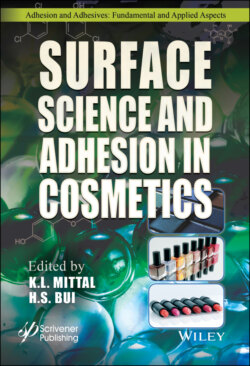Читать книгу Surface Science and Adhesion in Cosmetics - Группа авторов - Страница 35
2.1 Introduction
ОглавлениеWaxes are highly crystalline materials exhibiting a large melting enthalpy. Due to their high crystallinity, they are used as gelling agents or structural agents in many applications such as pharmaceuticals, foods, candles, coatings, inks and cosmetics. In cosmetic application, waxes are commonly used either in lipsticks to control the hardness of the lipstick structure or in a mascara to enhance the volume on eyelashes. In the lipstick formulations, wax is combined with oils to form an oil-wax gel system. The ability of a wax/oil system to form a crystalline network with specific characteristics such as texture and deposit depends on the concentration of the wax in the oils and on the type of wax. Hard wax with high melting temperature is used to control the hardness of solid lipstick, whereas soft wax with low melting temperature is used for texture. The common hard and soft waxes used in lipstick formulations are ozokerite, carnauba, candelilla, beeswax, polyethylene, paraffin wax and microcrystalline wax (Table 2.1).
For lipstick application, it is important to control the quality of the lipstick such as stability under hot or cold condition. On application, a good lipstick must be soft enough to slide on the lips and deposit a uniform layer of lipstick, but should be hard enough not to break under application. To balance the rigid structure of the lipstick and its deposit, the combination of both hard and soft waxes is necessary in the formulation. If the lipstick is too hard, the application will be draggy and less product will deposit on lips. If the lipstick is soft, the structure is not strong enough to be supported by the container and is easy to break during application. The soft lipstick is used to give creamy texture, thick deposit and shine from oils. Therefore, controlling the hardness and amount of deposit from oil-wax lipsticks is very important and challenging in lipstick formulation.
Table 2.1 Some common waxes used in lipstick formulations.
| Wax | Melting Temperature Tm (°C) |
| Polyethylene | 80-105 |
| Microcrystalline | 85-95 |
| Carnauba | 80-90 |
| Rice Bran | 70-80 |
| Ozokerite | 70-90 |
| Paraffin wax | 50-60 |
| Candelilla | 65-75 |
| Synthetic beeswax | 62-65 |
Due to increasing demands from consumers for natural products and environmental concerns, the common waxes from synthetic and petroleum sources used in the lipstick formulations such as polyethylene, microcrystalline and ozokerite waxes can be replaced by natural waxes [1–6]. Some commercial lipsticks claimed as natural lipsticks contain beeswax, candelilla and carnauba waxes as structure agents and natural plant oils. Candelilla and carnauba waxes are hard waxes with high melting points, therefore, they are commonly used together with low melting point beeswax to create the rigid structure for natural lipstick products. The common oils used in the natural lipstick formulations are olive oil, mineral oil, cocoa butter, jojoba oil, lanolin and petrolatum. The compositions of natural lipsticks or natural lip balms contain the ingredients shown in Table 2.2.
However, there is still lack of scientific understanding of natural waxes crystallized in various oils and in many natural ingredients which makes the natural lipstick formulations challenging in terms of structural stability, product spreadability and sensorial perception. Therefore, an understanding of the interactions of natural waxes with cosmetic oils or natural oils and with other ingredients in lipstick formulations is very important and necessary to achieve the best lipstick structure. This chapter will review the properties of some common natural waxes, the effect of oils on the oil-wax structures, and their potential applications in long-lasting cosmetics. Due to the complexity and inhomogeneity of chemical compositions of natural waxes, we used polyethylene wax in a simple oil-wax system as a model to investigate systematically the effect of oil viscosity and oil polarity on the lipstick structure.
Table 2.2 Typical composition of natural lipstick or lip balm [1–6].
| Ingredients | Examples |
| Natural waxes | Beeswax, carnauba wax, candelilla wax |
| Plant Oils | Castor oil, chamomile oil, jojoba oil, olive, coconut and sunflower oil |
| Plant-based emolients | Shea butter, cocoa butter, avocado, and aloe vera |
| Natural colors from fruits | Purple carrot, berries, pomegranate |
| Mineral colorants | Titanium dioxide, iron oxide, mica |
| Natural fragrances | Vanilla extract |
| Natural preservatives | Vitamin E from soy, honey |
